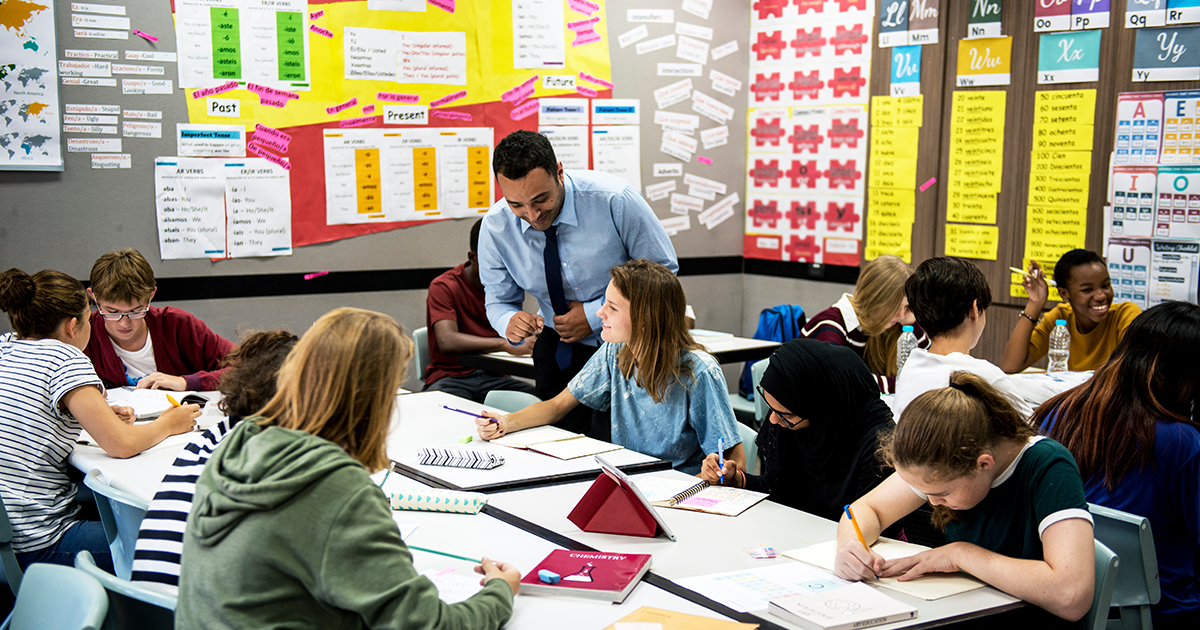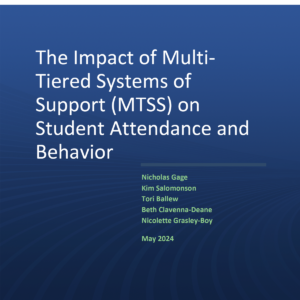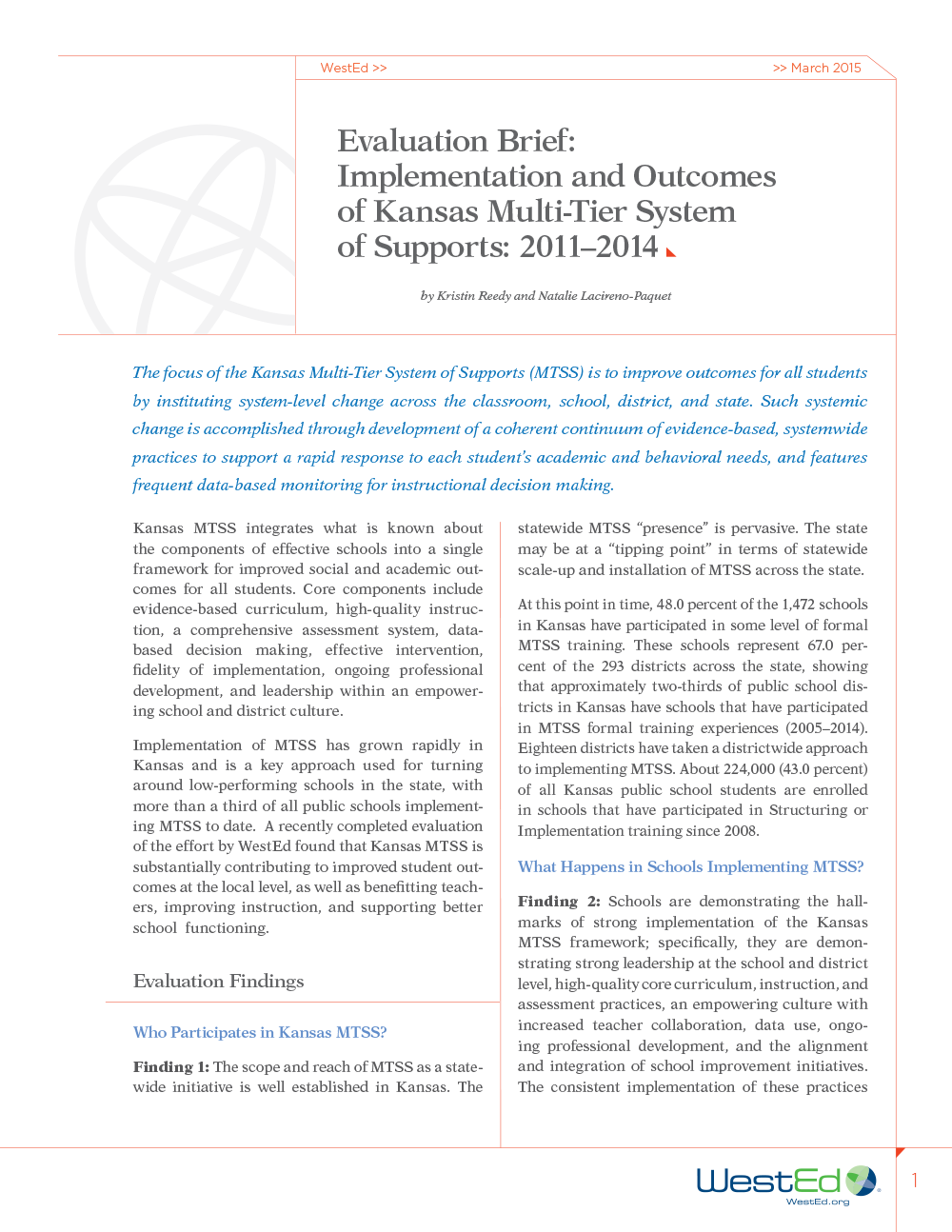WestEd Experts Shed Light on Five Common Myths About Multi-Tiered Systems of Supports
Posted on

Multi-Tiered System of Supports (MTSS) has been a buzzword in education for some time now, but there still needs to be more clarity about what it involves and how it functions within schools and districts.
In this blog post, WestEd experts Kimberly Salomonson, Tori Ballew, Beth Clavenna-Deane, and Paula Hough clarify five common misconceptions about this comprehensive framework and offer resources to inform discussions and decision-making.
Myth #1: Academic interventions are critical, but MTSS doesn’t support students in other areas.
If there is a perception that MTSS only supports academic interventions, it may be because an implementation has yet to fully embrace the comprehensive framework of an MTSS. MTSS supports all areas of student achievement, from academics to social-emotional learning (SEL) and behavior.
Through a tiered system of instruction and intervention, MTSS necessitates universal screening in both academics and SEL to determine skill deficits targeted for intervention, as well as regular review of attendance and behavior data. All data is then utilized multiple times a school year in a data-based decision-making process at the executive, site, grade and content area, and classroom levels to determine areas for growth, celebrate success, and identify trends.
In addition to targeting individual skill deficits and concerns through screening and regular review of data, a critical component of MTSS is strong, evidence-based Tier 1 Core or Universal Instruction. Through Tier 1 instruction, all students are provided explicit instruction and practice in core competencies of self-awareness, self-management, social awareness, relationship skills, and responsible decision-making.
Through universal instruction, intervention and support, and data-based decision-making, MTSS provides much more than academic interventions, as the framework is designed to integrate programming around the whole child.
Myth #2: MTSS is simply another term for special education.
The claim that MTSS is merely another term for special education is inaccurate and overlooks its comprehensive and preventative nature. Unlike special education, which specifically targets students with disabilities, MTSS is a holistic framework designed to support ALL students, regardless of their academic or behavioral needs.
MTSS includes multiple tiers of support that escalate in intensity, beginning with high-quality core instruction (Tier 1) for all students, targeted interventions (Tier 2) for those who need additional support, and intensive interventions (Tier 3) for those with significant needs (Fuchs & Fuchs, 2006).
Moreover, MTSS integrates data-driven decision-making and evidence-based practices to identify and address students’ needs early, often preventing the need for special education services. This proactive approach contrasts with the reactive nature of traditional special education, which typically intervenes after a student has already experienced significant difficulties (Batsche et al., 2005).
By addressing academic and behavioral issues early and effectively, MTSS aims to reduce the number of students requiring special education, promoting overall student success and well-being.
Myth #3: MTSS takes away from high-quality core instruction.
The assertion that MTSS detracts from high-quality core instruction is a common misconception. In reality, MTSS is designed to enhance core instruction by providing a structured framework that supports all students’ needs, ensuring no student falls behind.
MTSS emphasizes data-based decision-making, allowing educators to identify and address students’ academic and behavioral needs promptly. This proactive approach helps to maintain and even improve the quality of core instruction by ensuring it is responsive and adaptive to the diverse needs of the whole student population.
Moreover, research has shown that MTSS can lead to improved student outcomes and increased teacher effectiveness. According to the Center on Response to Intervention, MTSS frameworks, which include Response to Intervention (RTI) and Positive Behavioral Interventions and Supports (PBIS), promote high-quality instruction by emphasizing evidence-based teaching practices and ongoing professional development for educators.
By systematically addressing students’ learning gaps and behavioral issues, MTSS allows teachers to focus more effectively on delivering robust and inclusive core instruction. When these high-leverage actions are consistently applied, MTSS does not detract from high-quality core instruction; rather, MTSS fortifies it by ensuring all students receive the appropriate level of support to succeed academically and behaviorally.
Myth #4: The prescribed MTSS interventions might not work.
MTSS originated over twenty years ago from integrating the RTI and PBIS models. Both models ensured that students with learning gaps received appropriately matched interventions with the right time, frequency, and intensity to bridge those gaps and reach grade-level benchmarks. These components remain integral to an efficient MTSS. Years of research and practice have shown that educators must use valid and reliable screening and progress monitoring measures to determine who needs support and if the support is effective.
For interventions to be most effective, educators must analyze the results collaboratively using a problem-solving process. This combination of data-driven decision-making, evidence-based practices, and resources across all tiers ensures that the right interventions are implemented correctly and for the appropriate duration to support student growth.
When any components are missing or the MTSS is not well-designed, interventions may seem ineffective. The lack of impact is often due to other factors within the MTSS that are not functioning correctly. Ensuring high-quality Tier 1 core instruction and providing additional interventions is crucial for effectiveness. Proper implementation and sustainability of all MTSS components are essential for student success.
Myth #5: MTSS can be implemented at the site level without district support.
MTSS is an integral framework designed to address the diverse needs of all students by providing varying levels of support based on their individual needs. However, for MTSS to be effective, it must be embraced as a system-wide initiative. Implementing MTSS in a single classroom or one site in isolation is a daunting task fraught with challenges and is unlikely to yield the desired outcomes. MTSS relies heavily on consistent, collaborative practices and shared resources across the entire educational ecosystem (Batsche et al., 2005).
When MTSS is adopted system-wide, schools can ensure a cohesive approach to data-driven decision-making, which is essential for monitoring student progress and adjusting interventions as needed (Kilgus et al., 2016). Without a unified approach, efforts can become fragmented, leading to inefficiencies and a lack of accountability. Furthermore, a school-wide or district-wide adoption of MTSS allows for equitable access to supports and resources, ensuring that all students benefit from the framework, regardless of their classroom or site.
In conclusion, while implementing MTSS may seem overwhelming, the alternative—piecemeal adoption—significantly undermines the potential impact of this approach. For MTSS to fulfill its promise, it must be a collaborative, system-wide endeavor.
Fostering Inclusive and Supportive Education Environments
The journey toward a fully realized MTSS may be complex, but it is undoubtedly a step toward a more equitable and effective education system.
WestEd provides professional learning experiences for districts to develop an equitable MTSS framework that supports school and district leadership teams in making data-informed decisions about students’ academic, behavioral, and social-emotional needs.
Learn more about our Multi-Tiered System of Supports service.
 To address the need for effective MTSS implementation, WestEd recently engaged in a research and technical assistance partnership as subject matter experts that guided the design and implementation of effective MTSS. WestEd researchers simultaneously studied these efforts’ short-, mid-, and long-term effects on student outcomes.
To address the need for effective MTSS implementation, WestEd recently engaged in a research and technical assistance partnership as subject matter experts that guided the design and implementation of effective MTSS. WestEd researchers simultaneously studied these efforts’ short-, mid-, and long-term effects on student outcomes.
This interim report provides initial analyses of student-level impacts in one of the two school districts involved in the project. Learn more.
Thanks to these WestEd experts for sharing their expertise!
 Kimberly Salomonson specializes in local, county, and state educational policy and practice. She brings a powerful perspective to building system-wide coherence through culture shifts, coaching and collaborative team building, inclusive-minded and equity-based decision-making, sound resource and fiscal allocation practices, and instructional design.
Kimberly Salomonson specializes in local, county, and state educational policy and practice. She brings a powerful perspective to building system-wide coherence through culture shifts, coaching and collaborative team building, inclusive-minded and equity-based decision-making, sound resource and fiscal allocation practices, and instructional design.
 Victoria Ballew specializes in transforming underperforming districts and states by implementing principles aligned with Universal Design for Learning, MTSS, evidence-based interventions, fiscal competencies and allocations, inclusive practices, collaborative cultures, and equity-based decision-making.
Victoria Ballew specializes in transforming underperforming districts and states by implementing principles aligned with Universal Design for Learning, MTSS, evidence-based interventions, fiscal competencies and allocations, inclusive practices, collaborative cultures, and equity-based decision-making.
 Beth Clavenna-Deane specializes in building, implementing, and sustaining MTSS for academics and behavior. She focuses on sustaining evidence-based, inclusive instructional practices, such as differentiation, scaffolding, explicit instruction, and co-teaching while refining curricular efforts to achieve growth in academics, behavior, and social-emotional learning outcomes.
Beth Clavenna-Deane specializes in building, implementing, and sustaining MTSS for academics and behavior. She focuses on sustaining evidence-based, inclusive instructional practices, such as differentiation, scaffolding, explicit instruction, and co-teaching while refining curricular efforts to achieve growth in academics, behavior, and social-emotional learning outcomes.
 Paula Hough works with state and local agencies to build capacity to improve student learning conditions and outcomes. She supports systems as they create, implement, and refine practices to guide evidence-based practices and effective policy.
Paula Hough works with state and local agencies to build capacity to improve student learning conditions and outcomes. She supports systems as they create, implement, and refine practices to guide evidence-based practices and effective policy.
Additional Resources
- Center on Multi-Tiered System of Supports, Essential Components of RTI
- Center on Positive Behavioral Interventions & Supports: Introduction and FAQs
- Connecting Schoolwide SEL With Other School-Based Frameworks
- Considerations for Effective Implementation: 5 Elements of Fidelity
- Integration of SEL and Academic Instruction
- National Center on Response to Intervention: What is RTI?
- National PBIS Center: What Is PBIS?
References
Batsche, G., Elliott, J., Graden, J., Grimes, J., Kovaleski, J. F., Prasse, D., Reschly, D. J., Schrag, J., & Tilly, W. D. (2005). Response to Intervention: Policy Considerations and Implementation. National Association of State Directors of Special Education.
Fuchs, D., & Fuchs, L. S. (2006). Introduction to response to intervention: What, why, and how valid is it? Reading Research Quarterly, 41(1), 93–99.
Hannigan, J. D., & Hannigan, J. E. (2021). The MTSS start-up guide: Ensuring equity, access, and inclusivity for all students. Corwin.
Kilgus, S. P., Chafouleas, S. M., Riley-Tillman, T. C., & von der Embse, N. (2016). Direct behavior rating as a school-based behavior universal screener: Examination across time, grade level, and student risk status. School Psychology Review, 45(2), 236–253.
McCart, A., & Miller, D. (2020). Leading equity-based MTSS for all students. Corwin.
McIntosh, K., & Goodman, S. (2016). Integrated multi-tiered systems of support: blending RTI and PBIS. Guilford Press.
McLeskey, J., Spooner, F., Algozzine, B., & Waldron, N. L. (Eds.). (2014). Handbook of effective inclusive schools: Research and practice (1st ed.). Routledge.
Zhang, J., Martella, R. C., Kang, S., & Yenioglu, B. Y. (2023). Response to intervention (RTI)/multi-tiered system of supports (MTSS): A nationwide review. Journal of Educational Leadership and Policy Studies, 7(2), 1–26.


